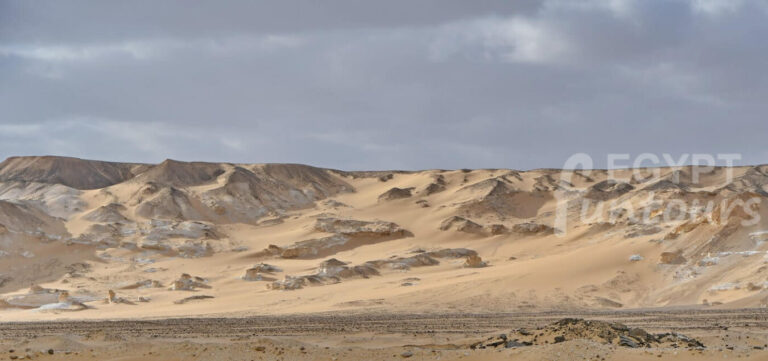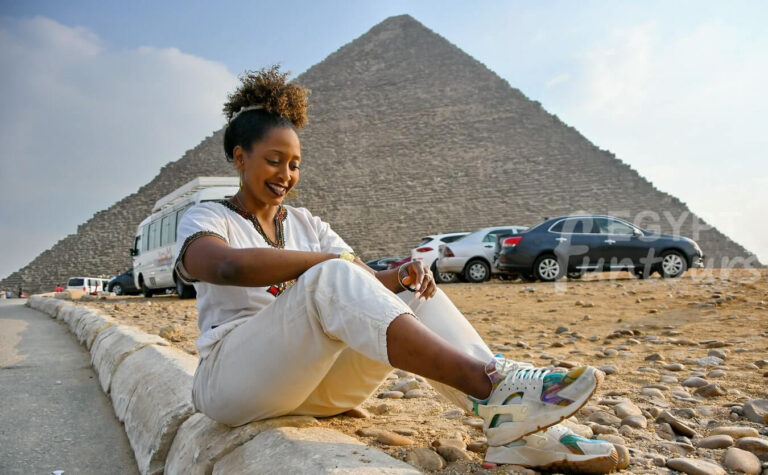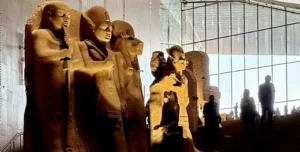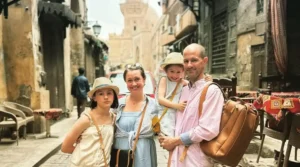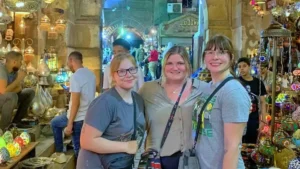Islamic Art in Egypt
Islamic art in Egypt is one of the earliest forms of Islamic art. Egypt became an Islamic state in 642 A.D. This was when it joined the Rashidun Caliphate. Since then, Egypt has been a source of Islamic culture. It went through many dynasties, including the Abbasid and Mamluk. Egypt also became an important cultural center. Here, architectural and creative styles developed. This included religious, civil, and military buildings. Art forms like glass, woodwork, and pottery flourished. Weaving and ceramics also thrived. Muslim artists used techniques like inlaying and grooving in metalwork.
Islamic Art in Egypt, Mashrabiya
 Mashrabiya or Oriel windows are among the most significant aesthetic and architectural aspects of the Islamic period. Influenced by decorative stone and stucco windows, Mashrabiyas were often built of lathe wood, allowing natural light and ventilation to enter the space via the hollows. Masharabiyas thrived during the Mamluk and Ottoman periods, beginning in the sixth century AH / thirteenth century A.D. These windows are unique in the world and characterize Egyptian home architecture.
Mashrabiya or Oriel windows are among the most significant aesthetic and architectural aspects of the Islamic period. Influenced by decorative stone and stucco windows, Mashrabiyas were often built of lathe wood, allowing natural light and ventilation to enter the space via the hollows. Masharabiyas thrived during the Mamluk and Ottoman periods, beginning in the sixth century AH / thirteenth century A.D. These windows are unique in the world and characterize Egyptian home architecture.
The Mashrabiya became an architectural and decorative element, as well as one of the most significant sources of natural illumination, because it enables sunlight to travel through the structure, providing both lighting and ventilation. It also allows ladies to view the outdoors without being noticed by people on the outside.
Despite its impact on many Eastern and European structures, the Mashrabiyas is one of the features of Egyptian urban architecture that we cannot discover in other nations. In addition to inlaying, grooving, and bracing, the Muslim artist was a master of metalworking.
Various disciplines of science, such as medicine, astronomy, and chemistry, as well as nature, developed throughout the Islamic civilization in Egypt. Many styles of Arabic calligraphy were invented here, including the Kufic, Naskh, and Thuluth, which may be seen on the walls of numerous structures, as well as the decoration of objects and manuscripts.
Islamic Art in Egypt – Textile
Textile manufacturing prospered throughout the Islamic period, particularly in the first Islamic capital (Fustat). The textile products reflected the wealth of the Fatimid period, attracting the attention of style houses at the time.
Their design was characterized by embroidered decorative bands, which were typically one or two horizontal rows of Kufi text with medallion and drawings, or two opposite lines (mirror) that carried the Caliph’s name, rank, ancestors, and date, or three embroidered bands are woven with silk towards the end of the Fatimid period, it evolved to four bands, while in Mamluk period, it included the prince’s blazons.
Brazons on Fabrics
Brazons were prominent in textiles during the Mamluk Period, and their depiction indicated the most important jobs undertaken by the trusted Mamluk princes. Among the most important of these jobs was that of the “Jukandar,” who was responsible for carrying the Polo stick and acting as a butler; symbolizing the cup. The blazon depicting a mule or donkey carrying a box or bag denotes the person in charge of the Sultan’s mail.
Islamic art in Egypt – Metalwork
During the Mamluk period, when copper and baser metals were widely used, Islamic metalwork varied in function and purpose. They decorated food bowls with floral ornaments. They also feature complex geometric shapes. These include stars and knots. We add Kufi and Naskh text as well and make side tables from copper. We inlay them with gold and silver. People use them to carry food trays in homes. They also use them to hold the Holy Qur’an in mosques. We decorate these tables with the same designs.
Touring Egypt’s Islamic sites is breathtaking. This art is a unique experience. You can only find it in Egypt. You can explore Cairo’s Islamic sites by booking one of our Egypt Vacation Packages. If you live in Cairo, you can learn more about this art. Take one of our Cairo Tours and Excursions.




